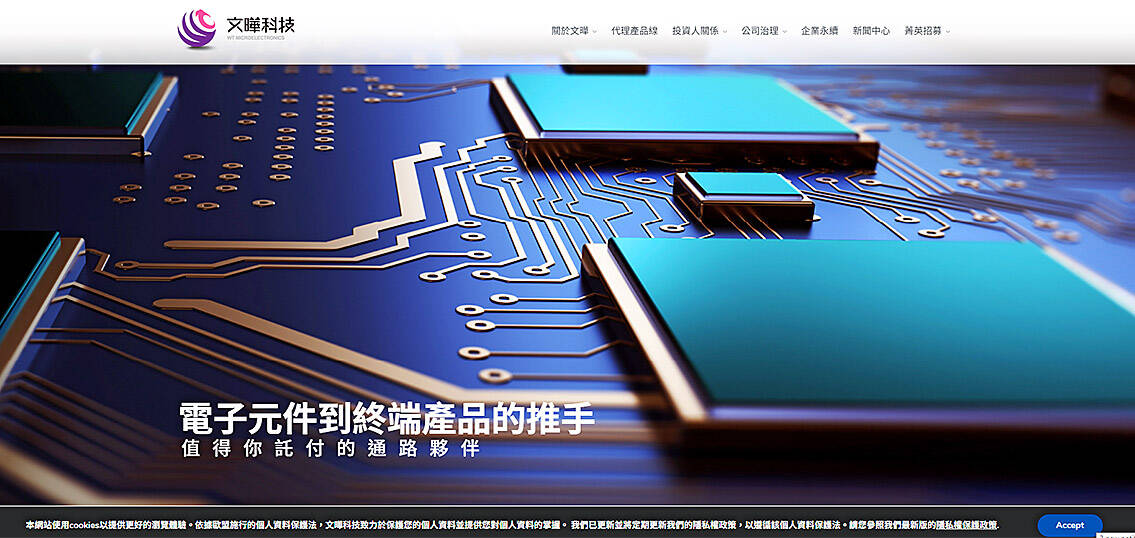Semiconductor components distributor WT Microelectronics Co (文曄科技) yesterday said it expects revenue this quarter to grow 16.5 percent from a year earlier, after posting better-than-expected revenue and profit for last quarter.
Based on the exchange rate assumption of NT$30.6 per US dollar, the mid-point guidance for fourth-quarter revenue is about NT$305 billion (US$9.87 billion), the company said in a statement, compared with NT$261.88 billion the previous year.
The mid-point guidance for net profit this quarter is set at NT$3.75 billion, an annual increase of about 48 percent, while the mid-point guidance for earnings per share (EPS) is NT$3.2, up 41 percent year-on-year, it said.

Photo: screen grab from WT Microelectronics Co’s Web site
WT Microelectronics, which was established in 1993, partners with more than 400 suppliers across major technology segments and serves more than 25,000 customers worldwide.
The semiconductor market faced challenges amid uncertainties including tariffs and foreign exchange fluctuations in the first half of this year, the company said.
However, the situation gradually stabilized in the second half, and demand for artificial intelligence (AI)-related semiconductors continued to strengthen, driving strong growth in its revenue and profit in the third quarter, it said.
During the third quarter, net profit was NT$3.82 billion, up 35 percent both quarterly and annually, and exceeding the upper end of previous guidance of NT$3.44 billion, while EPS came in at NT$3.4, a record-high, the company said.
Third-quarter revenue was NT$328.9 billion, up 27 percent quarter-on-quarter and 26 percent year-on-year, which also exceeded the upper end of its guidance of NT$299.5 billion, it added.
In the first three quarters of this year, the company earned NT$9.35 billion, up 42 percent year-on-year, with EPS of NT$8.11, while cumulative revenue grew 20 percent to NT$835.9 billion.
This quarter, sales of semiconductors used in data centers and servers are forecast to be slightly lower than last quarter, but significant market demand is expected to follow next year, the company said.
Sales of semiconductors for the consumer electronics, PC and mobile phone segments are also likely to decline from the previous quarter due to the traditional off-season effect, it said.
In non-AI segments, while there is still some inventory digestion of automotive semiconductors throughout the supply chain, the overall situation has stabilized, the company said, adding that it expects sales on this front to see a low single-digit percentage increase from last quarter.
Sales of industrial semiconductors this quarter are likely to see a low single-digit sequential decline as markets in Europe and the US enter a slow season, but the year-on-year growth trend remains unchanged, it said.
WT Microelectronics said it expects demand for AI to remain strong next year, particularly reflected in the continued growth of semiconductor shipments to the data center and communications markets.
“According to data center expansion plans announced by major cloud service providers, investment momentum in AI infrastructure is expected to persist, with demand for AI semiconductors likely to maintain a strong growth trajectory next year,” it said.

RUN IT BACK: A succesful first project working with hyperscalers to design chips encouraged MediaTek to start a second project, aiming to hit stride in 2028 MediaTek Inc (聯發科), the world’s biggest smartphone chip supplier, yesterday said it is engaging a second hyperscaler to help design artificial intelligence (AI) accelerators used in data centers following a similar project expected to generate revenue streams soon. The first AI accelerator project is to bring in US$1 billion revenue next year and several billion US dollars more in 2027, MediaTek chief executive officer Rick Tsai (蔡力行) told a virtual investor conference yesterday. The second AI accelerator project is expected to contribute to revenue beginning in 2028, Tsai said. MediaTek yesterday raised its revenue forecast for the global AI accelerator used

Taiwan Semiconductor Manufacturing Co (TSMC, 台積電) has secured three construction permits for its plan to build a state-of-the-art A14 wafer fab in Taichung, and is likely to start construction soon, the Central Taiwan Science Park Bureau said yesterday. Speaking with CNA, Wang Chun-chieh (王俊傑), deputy director general of the science park bureau, said the world’s largest contract chipmaker has received three construction permits — one to build a fab to roll out sophisticated chips, another to build a central utility plant to provide water and electricity for the facility and the other to build three office buildings. With the three permits, TSMC

TEMPORARY TRUCE: China has made concessions to ease rare earth trade controls, among others, while Washington holds fire on a 100% tariff on all Chinese goods China is effectively suspending implementation of additional export controls on rare earth metals and terminating investigations targeting US companies in the semiconductor supply chain, the White House announced. The White House on Saturday issued a fact sheet outlining some details of the trade pact agreed to earlier in the week by US President Donald Trump and Chinese President Xi Jinping (習近平) that aimed to ease tensions between the world’s two largest economies. Under the deal, China is to issue general licenses valid for exports of rare earths, gallium, germanium, antimony and graphite “for the benefit of US end users and their suppliers

Dutch chipmaker Nexperia BV’s China unit yesterday said that it had established sufficient inventories of finished goods and works-in-progress, and that its supply chain remained secure and stable after its parent halted wafer supplies. The Dutch company suspended supplies of wafers to its Chinese assembly plant a week ago, calling it “a direct consequence of the local management’s recent failure to comply with the agreed contractual payment terms,” Reuters reported on Friday last week. Its China unit called Nexperia’s suspension “unilateral” and “extremely irresponsible,” adding that the Dutch parent’s claim about contractual payment was “misleading and highly deceptive,” according to a statement